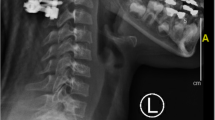Abstract
Grisel syndrome or atlantoaxial non-traumatic subluxation is a rare entity, poorly described in pediatric literature, although it is a pathology that usually appears in young children. The typical presentation is a torticollis with a previous surgical antecedent (mainly a surgery of the ear, nose, and throat area like adenoidectomy) or after an upper tract respiratory infection. A prompt diagnosis is essential for a successful evolution, and the treatment in most cases is conservative. We report a case of an 8-year-old girl with a typical evolution of this unusual complication. In our case, the most important element for diagnosis was the 3D CT scanner, and the treatment was conservative with a successful outcome. Pediatricians should be aware of this rare but potentially serious entity to establish the correct treatment and avoid complications.



Similar content being viewed by others
References
Battiata AP, Pazos G (2004) Grisel syndrome: the two-hit hypothesis—a case report and literature review. Ear Nose Throat J 83:553–555
Bell C (1830) The nervous system of the human body: embracing papers delivered to the Royal Society on the subjects of nerves. Longman, Rees, and Orme, London, p 403
Boccionlini C, Dall’ollio D et al (2005) Grisel’s syndrome: a rare complication following adenoidectomy. Acta Otorhinolaryngol Ital 25:245–249
Cowan TA, Inglis GS (1996) Atlanto-axial rotatory fixation: improved demonstration using spiral CT. Australas Radiol 40:119–124
Deichmueller CMC, Welkoborsky HJ (2010) Grisel´s syndrome—a rare complication following “sml” operations and infections in the ENT region. Eur Arch Otorhinolaryngol 267:1467–1473
Feldmann H, Meister EF, Kuttner K (2003) From the experts office. Atlanto-axial subluxation with spastic tortico after adenoidectomy resp. tonsillectomy in rose position—malpractice surgeon or anesthesiologist? Laryngorhinootologie 82:790–804
Fielding JW, Hawkins RJ (1977) Atlanto-axial rotatory fixation (fixed rotatory subluxationof the atlanto-axial joint). J Bone Joint Surg 59A:37–44
Fielding JW, Hawkins RJ, Hensinger RN, Francis WR (1978) Atlanto-axial rotator deformities. Orthop Clin North Am 9:955–967
Grisel P (1930) Enucleation de l´atlas et torticollis nasopharyngen. Presse Méd 38:50
Herzka A, Sponseller PD, Pyeritz RE (2000) Atlanto-axial rotatory subluxation in patients with Marfan syndrome. A report of three cases. Spine 25(4):524–526
Karkos PD, Benton J, Leong SC, Mushi E, Sivaji N, Assimakopoulos DA (2007) Grisel’s syndrome in otolaryngology: a systematic review. Int J Pediatr Otorhinolaryngol 71:1823–1827
Martínez L, Morales T, Cornejo EF (2002) Inflammatory C2-C3 subluxation: a Grysel syndrome variant. Laryngoscope 112:1445–1449
Meek MF, Hermens RAEC, Robinson PH (2001) La maladie de Grisel: spontaneous atlantoaxial subluxation. Cleft Palate-Craniofac J 38(3):268–270
Mezue WC, Taha ZM, Bashir EM (2002) Fever and acquired torticollis in hospitalized children. J Laryngol Otol 116:280–284
Patterson R, Little S (1943) Spasmodic torticollis. J Nerv Ment Dis 98:571–599
Tseng SH, Cheng Y (1998) Occiput-cervical fusion for symptomatic atlantoaxial subluxation in a 32-month-child with Down syndrome: a case report. Spinal Cord 36(7):520–522
Welinder NR, Hoffmann P, Hakansson S (1997) Pathogenesis of non-traumatic atlanto-axial subluxation (Grisel’s syndrome). Eur Arch Otorhinolaryngol 254:251–254
Wetzel FD, LaRocca H (1989) Grisel´s síndrome: a review. Clin Orthop Relat Res 240:141–152
Wilson BC, Jarvis BL, Haydon RC III (1987) Nontraumatic subluxation of the atloaxial joint: Grisel´s syndrome. Ann Otol Rhinol Laryngol 96:705–708
Acknowledgments
The authors gratefully acknowledge the assistance of Rachael Dix in manuscript’s edition.
Author information
Authors and Affiliations
Corresponding author
Additional information
Key points
-
1.
The main causes of Grisel syndrome are infection (48%) and post-adenotonsillectomy (31%).
-
2.
Less common causes include other postoperative cases such as pharyngoplasty and ear operations.
-
3.
Neurosurgical consultation is paramount in all cases, even the mild ones.
-
4.
In the majority of cases, conservative management in the form of bed rest, antibiotics, muscle relaxants, and collar with or without traction, is effective.
-
5.
In a few cases only, surgery in the form of arthrodesis is deemed necessary.
-
6.
Morbidity is significant in those cases where diagnosis is delayed, with the most devastating consequence, a permanent neurological deficit.
Rights and permissions
About this article
Cite this article
Ortega-Evangelio, G., Alcon, J.J., Alvarez-Pitti, J. et al. Eponym. Eur J Pediatr 170, 965–968 (2011). https://doi.org/10.1007/s00431-011-1493-7
Received:
Accepted:
Published:
Issue Date:
DOI: https://doi.org/10.1007/s00431-011-1493-7




